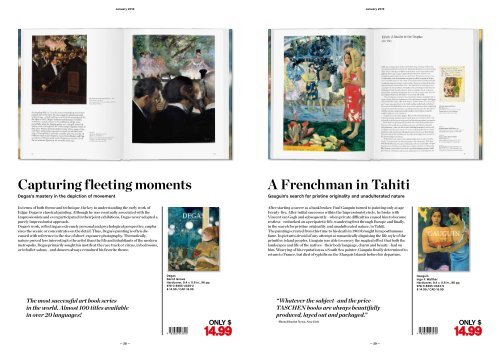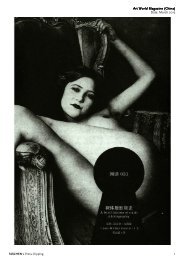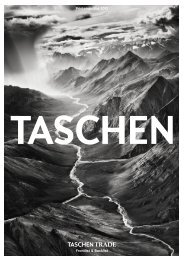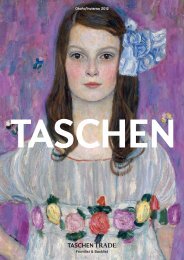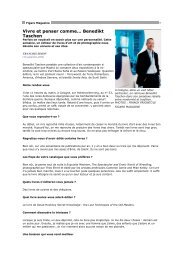STrUCTioN - Taschen
STrUCTioN - Taschen
STrUCTioN - Taschen
You also want an ePaper? Increase the reach of your titles
YUMPU automatically turns print PDFs into web optimized ePapers that Google loves.
January 2013<br />
January 2013<br />
Capturing fleeting moments<br />
Degas’s mastery in the depiction of movement<br />
A Frenchman in Tahiti<br />
Gauguin’s search for pristine originality and unadulterated nature<br />
In terms of both theme and technique, the key to understanding the early work of<br />
Edgar Degas is classical painting. Although he was eventually associated with the<br />
Impressionists and even participated in their joint exhibitions, Degas never adopted a<br />
purely Impressionist approach.<br />
Degas’s work, reflecting an extremely personal and psychological perspective, emphasizes<br />
the scenic or concentrates on the detail. Thus, Degas’s painting is often discussed<br />
with reference to the rise of short-exposure photography. Thematically,<br />
nature proved less interesting to the artist than the life and inhabitants of the modern<br />
metropolis. Degas primarily sought his motifs at the race track or circus, in bedrooms,<br />
or in ballet salons—and dancers always remained his favorite theme.<br />
After starting a career as a bank broker, Paul Gauguin turned to painting only at age<br />
twenty-five. After initial successes within the Impressionist circle, he broke with<br />
Vincent van Gogh and subsequently—when private difficulties caused him to become<br />
restless—embarked on a peripatetic life, wandering first through Europe and finally,<br />
in the search for pristine originality and unadulterated nature, to Tahiti.<br />
The paintings created from this time to his death in 1903 brought him posthumous<br />
fame. In pictures devoid of any attempt at romantically disguising the life style of the<br />
primitive island peoples, Gauguin was able to convey the magical effect that both the<br />
landscapes and life of the natives—their body language, charm and beauty—had on<br />
him. Wearying of his reputation as a South Sea painter, Gauguin finally determined to<br />
return to France, but died of syphilis on the Marquis Islands before his departure.<br />
Degas<br />
Bernd Growe<br />
Hardcover, 9.4 x 11.8 in., 96 pp.<br />
978-3-8365-4339-2<br />
$ 14.99 / CAD 16.99<br />
Gauguin<br />
Ingo F. Walther<br />
Hardcover, 9.4 x 11.8 in., 96 pp.<br />
978-3-8365-4343-9<br />
$ 14.99 / CAD 16.99<br />
The most successful art book series<br />
in the world. Almost 100 titles available<br />
in over 20 languages!<br />
,!7ID8D6-feddjc!<br />
Only $<br />
14.99<br />
“Whatever the subject–and the price–<br />
TASCHEN books are always beautifully<br />
produced, layed out and packaged.”<br />
—Photo District News, New York<br />
,!7ID8D6-fededj!<br />
Only $<br />
14.99<br />
— 28 — — 29 —


